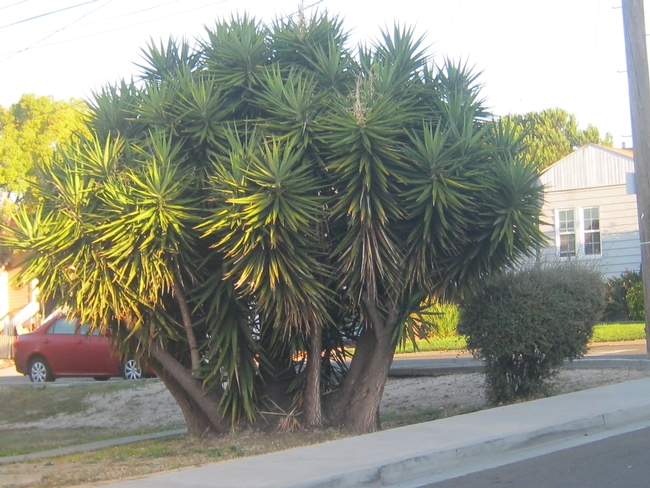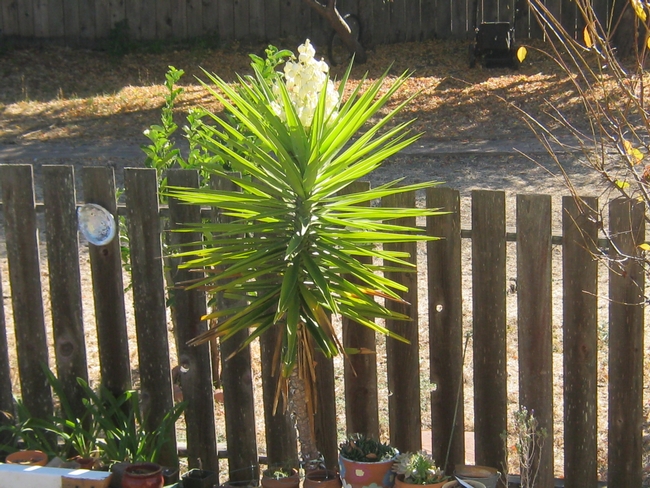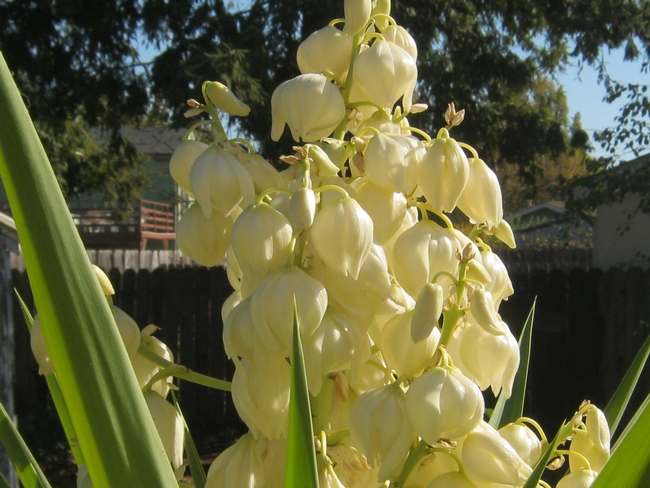Nine years have passed since I put my Yucca spp. in the ground. What a surprise to see a bloom in October. One trunk. One flower. Who knew. I started noticing other Yuccas in Vallejo and took photos of two multi-trunk, full-bodied specimens: one has several flowers, some fading; one is trimmed, healthy looking, well maintained. I'm not sure what variety I have or if it will remain a single trunk. I do know it's a slow-grower.
Yuccas are members of the Agave family. They are desert plants that are NOT fleshy (water-retaining plants that appear swollen, i.e. Aloe) and grow over much of North America. All have tough, sword-shaped leaves. Some are stemless clumps, others have trunks that can reach tree size. The bloom stalks are massed clusters with white/waxy cream-colored, round to bell-shaped flowers. They are best in well-drained soil, most need occasional deep soakings.
Four specimens that grow well in our area include:
Y. aloifolia (Spanish bayonet): Single or branching trunk, slow-growing to 10ft. Narrow, dark green leaves 2 feet long with sharp tips. Dramatic white flower stalk blooms in late spring/summer. Do not plant near walkways or well-travelled areas.
Y. filamentosa (Adam's Needle): From a broad base, it develops rounded sphere of bluish green leaves. Curly threadlike fibers peel off leaf margins. 'Bright Edge' (green centers with gold leaf margins), 'Color Guard' (bold center stripe of canary yellow).
Y. flaccida (weak-leaf yucca): Grows to tree size with age. Resembles Y. filamentosa, but leaves are narrower and less stiff, lower leaves become lax and curve downward. Several rosettes may form a small colony. 'Garland's Gold' and 'Gold Sword' (bear 1-2" wide leaves with golden yellow centers and dark green margins).
Y. pallida (pale yucca): Trunkless, but can eventually form a wide clump with up to 30 heads. Dramatic 18" x 18" rosettes with flexible, silvery blue leaves that arch gracefully and drape with age. Place in shade garden for textural interest or where low-growing form is needed.
A valuable resource for pests on all trees and shrubs (including Yucca) is Pests of Landscape Tree & Shrubs, an Integrated Pest Management Guide, published by the Statewide Integrated Pest Management Program, University of California Division of Agricultural and Natural Resources (Publication #3359). http://www.ipm.ucdavis.edu/IPMPROJECT/ADS/manual_landscape.html
The University of Florida IFAS Extension website has species' photos and decent information on both Agave and Yucca (requirements, placement, pests, diseases, cultural problems, propagation, toxicity, historical insight): http://edis.ifas.ufl.edu/ep419
Attached Images:


